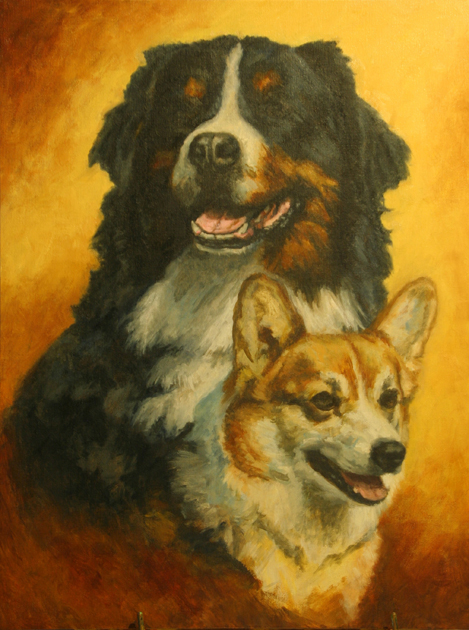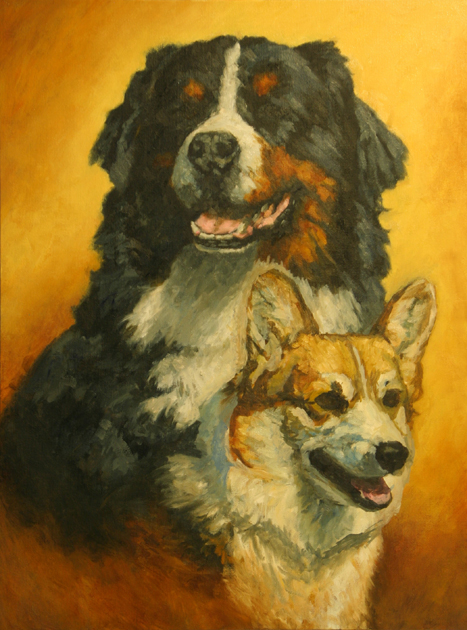Oil Painting Progression, Part 4 – “Solidity and Substance”
In our last discussion of the oil painting progression, I’d mentioned my concern that the many steps which I’d photographed in creating this piece might become boring to look at if I were to show every single one. So I’m going to skip over a photo here and there in an effort to get to the essence of the changes taking place without showing every little step. Today’s point of interest is what I call “solidity and substance.” In our last phase we saw the early establishment of form and texture in the dogs themselves. It’s very easy to begin to get attached to these early developments and want to assign them some kind of “preciousness” with fear of doing anything to disturb them. Well, today we’re going to blast through all that and talk about laying in the middle layers of paint that will set us up for the final surface work that will complete the oil painting.

“Larka & Dylan” (phase 4a) by Dean Vigyikan
In preparation for this important middle layer, I’m showing the above developments which include establishing some edges around the Bernese mountain dog, indicating the various directions of her fur. Throughout the painting process, I’m also frequently looking for slight (or not so slight) adjustments to proportion and position of any and all elements in the painting, one in relation to the other. This pays off in avoiding any particular feature of the subject looking “weird” in the end because the artist was too lazy to put his or her observational skills to work throughout the painting’s progress, taking care of things that look “off” before they become permanent fixtures in the work.trailer movie J. Cole: 4 Your Eyez Only 2017
Comparing the painting’s progress today to where we were in the previous installment, it’s pretty clear that the opacity, or density of color is noticeably increasing in the mountain dog, and I’m very happy with this effect. It is in fact the very element I’m referring to in describing “solidity and substance” in this article. While the illusion of three dimensional form in the dogs is an important end goal, that’s not what I mean by “solidity” in this particular case. The solidity I’m talking about means creating a feeling of “solidness” or “substance” to the paint surface itself. Now this could arguably be seen as a purely subjective matter of taste, and that would be correct. Some artists and viewers prefer a thinner more transparent feel to a finished piece of art. Such effects may be exquisitely employed, and not only in watercolor painting where they’d be widely expected. However, in a traditional oil painting like this one, I tend to gravitate toward a substantial feeling of solid paint on the surface of the work. Yes, there can be translucency between the layers of paint, but I’m trying to avoid getting a washy effect, so I make it a point to build up the paint’s opacity.

“Larka & Dylan” (phase 4b) by Dean Vigyikan
Now, in the second image here, I’ve gone into the corgi dog with some bolder, heavier brushwork to get him up to the level of his larger companion with regard to this feeling of opacity. This is where I was up against that tendency to see a “preciousness” in the earlier phase of the painting. In the first of these two images, there’s some nice softness and subtlety going on in the surfaces of the corgi’s fur. And one might ask, “yes, so why mess it up?” A fair question, and again that becomes a matter of taste. It may not show up so well in the photo, but along with that soft and subtle texture to the dog’s fur was a transparency and thinness to the paint itself which was not at all the kind of surface I wanted to achieve in the finished work. And so, following the values of light and dark which I’d established previously, I went in with some heavier paint and took care of business, getting that substantial layer of paint put into place. It can be noted too that I’ve further added this kind of thick, bold brushwork to the mountain dog as well. While these thick strokes may appear to obliterate all the work I did previously, the time spent on those previous layers was not wasted. The early strokes not only show through in certain areas, but they also established the proper patterns of color, light, and dark, and create a necessary underpainting which allows these newer strokes to appear as bold as they’re meant to. So now, though they may appear a bit rougher in texture than they did in previous stages, both of the dogs have a new level of substance and solidity in the paint itself, and this sets us up for the great fun of laying in the final brushstrokes that will complete the painting!
